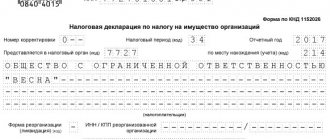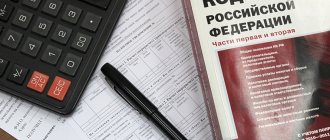During the existence of the property tax, various changes occurred with it. Mostly they concerned objects and the tax base. For example, since 2015, the tax base began to be determined on the basis of the cadastral value, and organizations using UTII and the simplified tax system were included in the payment of tax. And in 2021, movable property returned to the object of taxation; it was again excluded from the list of objects of taxation. Let us recall the main aspects relating to the corporate property tax, which relates to regional taxes, and also inform you of the main changes in 2021.
Object of taxation
The objects of taxation are:
1) for Russian organizations - real estate , recorded on the balance sheet as fixed assets (Article 374 of the Tax Code of the Russian Federation);
2) real estate located on the territory of the Russian Federation and owned by organizations on the right of ownership or right of economic management, as well as received under a concession agreement, if the tax base for such property is determined as their cadastral value entered into the Unified State Register of Real Estate ( Article 375 of the Tax Code of the Russian Federation);
Real estate criteria:
- the presence of a strong connection between the object and the ground (for example, the construction of the object on a monolithic reinforced concrete foundation, the functional or technological connection of this object with other objects by underground communications (cable power lines laid in underground trenches, etc.));
- moving an object is impossible without disproportionate damage to its purpose (including the ability of the object to act in civil circulation as a separate object of civil rights (as opposed to objects that perform an exclusively servicing (auxiliary) function in relation to real estate, including land plots, buildings , structures); the presence of independent useful properties of the object that can be used in economic activity regardless of the land plot on which it is located and other real estate objects located on the common land plot).
These can be buildings, structures, unfinished construction projects, premises, parking spaces, residential buildings, apartments, rooms, cottages and garages. In accordance with the Civil Code of the Russian Federation, real rights to real estate are subject to state registration in the Unified State Register of Real Estate. At the same time, property for which such state registration has not been carried out can also be recognized as real estate. To reasonably classify property as real estate, it is necessary to take into account not only the presence/absence of a record about the object in the Unified State Register of Real Estate, but also the presence of grounds confirming the strong connection of the object with the land and the impossibility of moving it without disproportionate damage to its purpose. For example, for capital construction projects, such grounds may be documents that contain information about the relevant characteristics of the object (technical accounting or technical inventory documents, permits for construction and/or commissioning of the object, design documentation, etc.).
Foreign organizations operating in the Russian Federation through permanent representative offices keep records of taxable items in the manner established in the Russian Federation for accounting.
Movable property recorded on the balance sheet as fixed assets from January 1, 2021 is not subject to property tax.
The list of objects not subject to taxation for corporate property tax is specified in the Tax Code (clause 4 of Article 374 of the Tax Code of the Russian Federation):
- land plots and other environmental management facilities (water bodies and other natural resources);
- property owned by the right of operational management to federal executive bodies and federal state bodies in which the legislation of the Russian Federation provides for military and (or) equivalent service, used by these bodies for the needs of defense, civil defense, security and law enforcement in the Russian Federation ;
- objects recognized as objects of cultural heritage (historical and cultural monuments) of the peoples of the Russian Federation of federal significance in the manner established by the legislation of the Russian Federation;
- nuclear installations used for scientific purposes, storage facilities for nuclear materials and radioactive substances and radioactive waste storage facilities;
- icebreakers, ships with nuclear power plants and nuclear technology service ships;
- space objects;
- ships registered in the Russian International Register of Ships;
- vessels registered in the Russian Open Register of Vessels by persons who have received the status of a participant in a special administrative region in accordance with Federal Law of August 3, 2021 N 291-FZ “On Special Administrative Regions in the Territories of the Kaliningrad Region and Primorsky Territory”;
- aircraft registered in the State Register of Civil Aircraft by persons who have received the status of a participant in a special administrative region in accordance with Federal Law of August 3, 2021 N 291-FZ “On special administrative regions in the territories of the Kaliningrad Region and Primorsky Territory”.
Federal benefits
Federal tax benefits are established by Article 381 of the Tax Code of the Russian Federation. Their effect extends to the entire territory of Russia, regardless of their mention in regional laws.
Federal tax benefits can be divided into two types:
- benefits that completely exempt an organization from paying property taxes. Such benefits, in particular, are provided for specialized prosthetic and orthopedic enterprises (clause 13 of Article 381 of the Tax Code of the Russian Federation), bar associations, law offices and legal consultations (clause 14 of Article 381 of the Tax Code of the Russian Federation), state scientific centers (clause 15 Article 381 of the Tax Code of the Russian Federation), management companies and organizations - participants in the Skolkovo project (clauses 19, 20 of Article 381 of the Tax Code of the Russian Federation);
- benefits that apply to certain types of fixed assets owned by the organization. For example, such benefits are established for certain types of property of institutions of the penal system (clause 1 of Article 381 of the Tax Code of the Russian Federation), religious associations (clause 2 of Article 381 of the Tax Code of the Russian Federation), etc.
The categories of beneficiaries and preferential property are given in more detail in the table.
Situation: is it necessary to pay property tax on the real estate of a bar association if part of its own premises is leased?
No no need.
The property of bar associations, law offices and legal consultations is exempt from taxation (clause 14 of article 381 of the Tax Code of the Russian Federation). At the same time, the Tax Code of the Russian Federation does not establish any restrictions regarding the use of preferential property. Thus, those objects that are not directly used in legal practice also fall under the benefit.
Criteria for fixed assets
Fixed assets from an accounting point of view are assets that meet the following conditions:
- the object is intended for use in the production of products , performance of work, provision of services;
- the object is intended for use for a period exceeding 12 months ;
- subsequent resale of the object is not expected;
- the object is capable of generating economic benefits .
The criteria for fixed assets for tax purposes are somewhat different from those for accounting and are established by Chapter 25 of the Tax Code, namely, paragraph 1 of Article 256. In the Tax Code, fixed assets are classified as depreciable property. The following property is considered depreciable:
- Is owned or operated by the organization. Exception: fixed assets, the right to which is subject to mandatory state registration, are included in depreciable property from the moment the documents are submitted, clause 11 of Article 258 of the Tax Code;
- Used for the purpose of generating income;
- Intended for use over 12 months;
- Costing more than 40,000 rubles. From the beginning of 2021 For tax purposes, property with an original cost of 100 thousand rubles or more will be considered depreciable.
Please note: That property that meets all the criteria, but is less than the cost limit, is written off as material expenses.
How is property tax calculated for the entire tax period: stages of calculation
When calculating property tax for the year, the following actions are carried out:
- The property that is taxed is isolated from the total volume, that is, the object of taxation is determined. To do this, the value of non-taxable property and those amounts of fixed assets on which the tax is calculated separately are subtracted from the value of the property (clause 4 of Article 374, clause 1 of Article 376 and clause 3 of Article 382 of the Tax Code of the Russian Federation).
- The average value of this property for the year (tax period) is determined, that is, the tax base is calculated. In this case, tax exemption benefits should be taken into account in the calculation.
- The tax base is multiplied by the tax rate.
- Available tax and payment reduction benefits made abroad are used.
The tax base
In general, the tax base for the property tax of legal entities is determined as the average annual value of property recognized as an object of taxation, and such property must be accounted for at its residual value.
Taking into account the changes of 2014, in relation to individual real estate objects, the tax base is now determined as their cadastral value. Since 01.01.2020, the Tax Code of the Russian Federation classifies not only fixed assets, but also any real estate owned by organizations under the right of ownership or right of economic management, as objects of taxation at cadastral value. Thus, it will not matter whether real estate is taken into account as a fixed asset or not - you will still have to charge and pay tax according to the cadastre. True, unless the region decides otherwise. Previously, if objects were not registered as fixed assets, tax, according to cadastral valuation, was not paid on them.
List of real estate taxed by legal entities at cadastral value (Article 378.2 of the Tax Code of the Russian Federation):
- administrative and business centers and shopping centers (complexes) and premises in them;
- non-residential premises, the purpose, permitted use or name of which, in accordance with the information contained in the Unified State Register of Real Estate, or documents of technical registration (inventory) of real estate, provides for the placement of offices, retail facilities, public catering and consumer services, or which are actually used for placement offices, retail facilities, public catering and consumer services;
- objects of real estate of foreign organizations that do not carry out activities in the Russian Federation through permanent missions, as well as objects of real estate of foreign organizations not related to the activities of these organizations in the Russian Federation through permanent missions;
- residential premises, garages, parking spaces, unfinished construction projects, as well as residential buildings, garden houses, outbuildings or structures located on land plots provided for personal farming, vegetable gardening, horticulture or individual housing construction.
To pay tax at cadastral value, two conditions must be met:
- the cadastral value of the objects has been established;
- Regional laws indicate that objects are taxed at cadastral value.
If at least one of these requirements is not met, the tax on such objects must be calculated at the average annual cost, provided that they are taken into account in accounting as fixed assets. Exception: organizations on the simplified tax system and UTII. They do not pay tax on the average annual cost of new properties (clause 2 of article 346.11, clause 4 of article 346.26 of the Tax Code)
Data on cadastral value can be found:
- on the Rosreestr website;
- Public cadastral map;
- Government services.
Procedure for calculating property tax
The amount of property tax is determined as the product of the tax base and the rate approved by the regional authorities for the corresponding reporting period. Rate indicators may differ depending on the territorial affiliation of the taxpayer. You can check the current values on the Federal Tax Service website, but the maximum value cannot exceed 2.2%.
First of all, we determine the tax base.
Option No. 1. At average annual cost
The calculation is carried out using the formula for calculating the property tax of an organization:
SrGodSt = (OS1 + OS2 + … + OSp1 + OSp2) / (M + 1),
Where:
- SrGodSt - average annual value of property for the tax period;
- OS1, OS2... - the residual value of the property as of the 1st day of each month of the tax period;
- OSp1 - the residual value of the property as of the 1st day of the last month of the tax period;
- OSp2 - the residual value of the property as of the last day of the last month of the tax period;
- M is the number of months in the tax period.
According to general rules, taxpayers are required to calculate and pay advance payments based on the results of reporting periods (quarters). For example, to calculate the advance payment for 9 months of 2021, enter 10 (9+1) as the denominator. Divide the resulting amount by 4, and only then apply the corporate property tax rate, example calculation below.
Option No. 2. At cadastral value
We calculate the property tax of organizations using the formula:
Tax amount = cadastral value × property tax rate.
To calculate, use the value of the cadastral price of real estate approved as of January 1 of the year for which you are calculating the corporate property tax. You can find out the indicator online - on the official website of Rosreestr.
Calculate the advance tranche using the formula:
Advance payment = cadastral value × tax rate / 4.
Do not forget that the obligation to pay advance payments for property tax of organizations is established by regional authorities.
Example of how to calculate tax
Residual value of real estate properties of VESNA LLC, numbers taken according to accounting data:
| date | Amount in rubles |
| 01.01 | 15 000 000 |
| 01.02 | 14 900 000 |
| 01.03 | 14 800 000 |
| 01.04 | 14 700 000 |
| 01.05 | 14 600 000 |
| 01.06 | 14 500 000 |
| 01.07 | 14 400 000 |
| 01.08 | 15 750 000 |
| 01.09 | 15 600 000 |
| 01.10 | 15 500 000 |
| 01.11 | 15 400 000 |
| 01.12 | 15 300 000 |
| 31.12 | 15 200 000 |
| TOTAL | 195 650 000 |
An example of calculating property tax.
Step No. 1. Calculate the average annual cost of real estate.
195,650,000 / 13 = 15,050,000 rubles.
Step No. 2. Calculate the annual tax payment.
Formula for calculating the property tax of an organization:
Tax base × tax rate in a particular region. According to the conditions of the example, we will take into account the maximum corporate property tax rate - 2.2%.
Calculation example:
15,050,000 × 2.2% = 331,100 rubles.
The payment amount should be rounded to the nearest ruble. We discard amounts less than 50 kopecks, and round up amounts greater than 50 kopecks to the nearest ruble.
Step No. 3. We calculate advance payments for property taxes.
Calculation for 1st quarter:
Art. real estate = (15,000,000 + 14,900,000 + 14,800,000 + 14,700,000) / 4 = 14,850,000 rub.
Advance amount for property tax for 1 sq. = 14,850,000 / 4 × 2.2% = 81,675 rub.
1st half of the year:
Art. ND = (15,000,000 + 14,900,000 + 14,800,000 + 14,700,000 + 14,600,000 + 14,500,000 + 14,400,000) / 7 = 14,700,000 rub.
Amount of property tax for 6 months: 14,700,000 / 4 × 2.2% = 80,850 rubles.
9 months:
Art. ND = (15,000,000 + 14,900,000 + 14,800,000 + 14,700,000 + 14,600,000 + 14,500,000 + 14,400,000 + 15,750,000 + 15,600,000 + 15,500,000) / 10 = 14,975,000 rub. .
Advance for 9 months: 14,975,000 / 4 × 2.2% = 82,362.50 rubles. Payable: 82,363 rubles, as it is necessary to round the amount.
Step No. 4. Calculate the final property tax for the year:
311,100 – 81,675 – 80,850 – 82,363 = 86,212 rubles.
Procedure for calculation and payment
The amount of property tax for organizations is calculated based on the results of the tax period to which the calendar year relates.
From 01/01/2020 Tax calculations for advance payments based on the results of reporting periods (I quarter, I half of the year, 9 months) do not need to be submitted (clause 2 of Article 386 of the Tax Code of the Russian Federation will no longer be in force). However, the obligation to make advance payments has not been cancelled. They must be transferred to the budget according to the old rules.
Also, based on the results of each reporting period (first quarter, half of the year and nine), it is necessary to calculate the amount of advance payments in the amount of 1/4 of the product of the tax base and the tax rate. Thus, the final amount of tax payable to the budget is determined as the difference between the amount of tax for the tax period and the amounts of advance payments .
What is the difference between paying property tax by Russian and foreign organizations? Property tax and advance payments are subject to payment by the taxpayer in the manner and within the time limits established by the constituent entities of the Russian Federation.
However, in relation to property located on the balance sheet of a Russian organization, tax and advance payments are subject to payment to the budget at the location of the specified organization. Foreign organizations operating in the Russian Federation through permanent representative offices pay taxes and advance payments to the budget at the place where these permanent representative offices are registered with the tax authorities.
How to calculate property tax for a legal entity: general principles
Property tax by legal entities must be paid at the end of the year and can be transferred throughout the year in the form of advances at the end of each quarter.
The issue of availability and obligation to pay advances is decided at the regional level. If they are introduced, then organizations make advance payments 3 times a year: after the 1st quarter, 6 months and 9 months. However, advances may not be made. This happens in the following cases:
- if a subject of the Russian Federation, in accordance with clause 3 of Art. 379 of the Tax Code of the Russian Federation, does not introduce the payment of advance payments;
- if regional authorities, in accordance with paragraph 6 of Art. 382 of the Tax Code of the Russian Federation, establish for some categories of legal entities the right not to count or pay advances.
To learn how and for whom property tax exemption can be introduced, read the article “Who is exempt from paying property tax?” .
Deadlines for submitting reports
From January 1, 2021, taxpayers will report property taxes only based on the results of the tax period. There is no longer a need to submit quarterly calculations of advance payments to the Federal Tax Service. The form of the declaration, as well as the procedure and format for its submission, were approved by Order of the Federal Tax Service of the Russian Federation dated August 14, 2019 No. SA-7-21/ [email protected]
If a taxpayer is registered with several tax authorities of one constituent entity of the Russian Federation at the location of real estate, the tax base for which is determined as the average annual cost, then the taxpayer is assigned the right to submit a single property tax return. Now the taxpayer can choose the tax authority to which he will submit the declaration, but is obliged annually before March 1 of the year, which is the tax period, to notify the tax authority of the constituent entity of the Russian Federation about this. The notification form was approved by order of the Federal Tax Service of Russia dated June 19, 2019 No. ММВ-7-21/ [email protected]
The deadline for submitting the declaration is no later than March 30 of the year following the tax period.
Property tax declaration
Please note that by Order of the Federal Tax Service dated August 14, 2019 No. SA-7-21/ [email protected] as amended on July 28, 2020, a new form of property tax declaration for 2021 was approved. The order comes into force on November 3, 2020. Based on the results of 2021 (before April 1, 2021), you already need to report using the new form.
Rules for filling out a declaration with line-by-line comments from the appendix to the Order of the Federal Tax Service of the Russian Federation dated August 14, 2019 No. SA-7-21/ [email protected]
In the first section, line 005 “Taxpayer Attribute” was added, which is related to coronavirus benefits, and line 007 “SZPK Attribute” for organizations that have entered into an agreement on the protection and promotion of capital investments. For section two, new codes for coronavirus federal and regional benefits were approved, as well as a special code for the property of FEZ participants.
The most important innovation is the appearance of the fourth section, in which organizations will again have to reflect information on the average annual value of movable property recorded on the balance sheet as fixed assets (it is still not subject to tax). The amendments are being made to assess the value of movable property, which is currently exempt from tax. It is planned that taxation of movable property will return in the near future, but tax rates will be reduced.
Calculation of property tax for legal entities
Currently, taxes are calculated in most cases using accounting software. I'll tell you how we will do this in 2021 using a short example.
LLC "A" is registered in the Smolensk region, applies the general taxation system, has equipment worth 1,200,000 rubles and a car worth 600,000 rubles on its balance sheet. The property was purchased for a fee. In the Smolensk region, the tax rate on real estate is 2.2%, on movable property - 1.1%. Let's consider the procedure based on the above conditions.
- We set property tax rates. To do this, open “Settings” - “Taxes and reports” - “Property tax”. We set the tax rates approved for the Smolensk region for movable and immovable property;
- In the directory “Nomenclature” and “Fixed Assets” we fill in the data on our property: name, financially responsible person (MRP), method of recording expenses, benefits, inventory card;
- We accept equipment for registration. In the section “OS and intangible assets” we fill out the document “Receipt of equipment”. Then, in the “OS and intangible assets” section, fill out the “Acceptance for accounting” document. We reflect the initial cost of the equipment, useful life, and method of calculating depreciation;
- We accept the car for accounting. In the section “Fixed assets and intangible assets” we fill out the document “Receipt of fixed assets”, we fill in the initial cost, car accounting and depreciation accounts, useful life (service life);
- We perform month closing every month. The program automatically calculates depreciation and writes it off to the organization's expenses;
- When closing the quarter, the program automatically calculates the tax. In the balance sheet, property tax will be reflected in account 68.08.
If you do not use an accounting program or need to calculate some special case, we recommend an online calculator to calculate the property tax of organizations.
How is property tax calculated for the quarter?
To obtain the data included in the above formula when calculating property tax advances in 2021, taxed on the basis of the average annual value, the following actions are performed:
- The property that is taxed is isolated from the total volume, that is, the object of taxation is determined. To do this, the value of non-taxable property and the value of those fixed assets for which the tax is calculated separately are subtracted from the value of the property (clause 4 of Article 374, clause 1 of Article 376 and clause 3 of Article 382 of the Tax Code of the Russian Federation).
Read about the specifics of taxation of movable property in 2018 in the material “Tax on movable property of organizations from 2021”. And from 2021, movable property is exempt from taxation. See details here
- The average cost of this property for the quarter (reporting period) is determined, that is, the tax base for advances is calculated. In this case, tax exemption benefits should be taken into account in the calculation.
How to calculate the average cost of fixed assets, read the material “Formula for calculating the average annual cost of fixed assets.”
- The tax base is multiplied by the tax rate.
- 1/4 of the resulting product is allocated.
- Available tax reduction benefits are used.
Payment of property tax by organizations under special regimes
We are talking about the entry into force of Federal Law No. 52-FZ of 04/02/2014, according to which the obligation of these taxpayers to pay property tax in respect of real estate is established, the tax base for which is determined as its cadastral value. Who does this innovation apply to? The new rule applies both to organizations using the simplified tax system and to organizations using UTII.
What is the difference between innovations for simplifiers and companies on UTII? For companies using UTII, the obligation to pay property tax arose on July 1, 2014, while organizations using the simplified tax system began on January 1, 2015.
Local authorities are obliged to approve, in accordance with the established procedure, the results of determining the cadastral value of objects. Moreover, they must conduct a cadastral valuation of real estate at least once every five years. A list of real estate objects in respect of which the new taxation procedure applies must also be determined. Thus, it is important to remember that now, in relation to individual fixed assets, the tax base for corporate property tax is calculated based on the cadastral value. And the tax on such property of organizations will now have to be paid by both simplified organizations and organizations under imputation.
Firmmaker, August 2014 (updated in January 2021) Alina Marina When using the material, a link is required
How is property tax calculated?
How to calculate corporate property tax? The rules for calculating this tax are regulated by 2 documents:
- Tax Code of the Russian Federation;
- The procedure for filling out a tax return for the property tax of organizations, approved by order of the Federal Tax Service of Russia dated August 14, 2019 No. SA-7-21/ [email protected] (hereinafter referred to as the Procedure for filling out the declaration).
Property tax is calculated by:
- Organizations on OSNO based on the average annual value of property and tax rate.
- All companies, regardless of the taxation system applied to certain types of real estate. The tax must be calculated based on the cadastral value established as of January 1 of the tax period and the tax rate.
Tax rates are set by regional authorities, but their value should not exceed the rates prescribed in the Tax Code.
The amount of property tax, according to paragraph 1 of Art. 382 of the Tax Code of the Russian Federation, it is necessary to calculate both for the reporting period (if it is introduced in the region) and for the entire tax period.
To learn how tax accrual is reflected in accounting entries, read the material “Property tax accrued - accounting entries .
How to use the calculator
Instructions for using the property tax calculator for legal entities
- Enter the tax rate (default 2.2%) and the residual value of fixed assets (property) for all periods.
- Click "CALCULATE". The calculator will calculate the total amount of property tax for the year, the average annual value of the property, the amount of advance payments and the amount of tax to be paid additionally.
The property tax calculator for legal entities is a simple and reliable assistant to the accountant in working on tax reports, including in calculating the property tax of a business entity.
There will be no need to submit tax calculations for advance payments.
The obligation to submit tax calculations for advance payments of corporate property tax (based on the results of reporting periods - the first quarter, the first half of the year, 9 months) will be canceled starting from the tax period of 2021.
The change is provided for by Federal Law No. 63-FZ dated April 15, 2019 - clause 2 of Art. 386 of the Tax Code of the Russian Federation will lose force. Thus, from January 1, 2021, taxpayers will report property taxes only based on the results of the tax period.
The Federal Tax Service website notes that this measure, along with the abolition of the obligation to submit tax returns for transport and land taxes, is needed to reduce the administrative burden in the form of excessive reporting for participants in tax relations.
Who is subject to and who is exempt from paying property tax in 2021
The legislation established a list of entities that are required to make mandatory payments for the use of certain property in their activities, as well as a list of those who are exempt from paying this tax.
According to the general rules, the first group includes all organizations that have property defined by regional regulations, and also use it in their activities. The exact list of these organizations is enshrined in laws.
The second group includes subjects that are exceptions to the general rule. We are talking about persons who have the legal right not to make property tax payments, even if they use property in their activities. For example, in 2014, all organizers of the Winter Olympic Games were exempt from property tax. To view the current list of exempt companies, you must contact your regional tax office.








